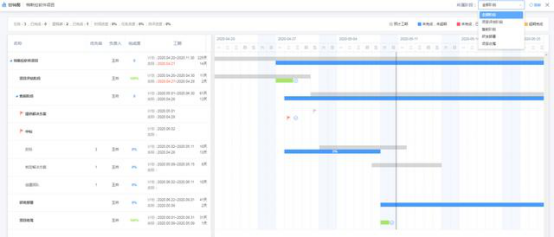Project progress management, also known as time management or construction period management, is a series of management processes carried out to ensure that the project is completed on time.
Before project execution begins, the project manager will determine whether the planned end date is achievable and establish a draft project schedule based on estimates of project scope, resources, etc. Then through communication and coordination with project team members and key project stakeholders, the project schedule is finally modified and determined. By creating a complete project schedule, project personnel can have a complete understanding of the work required to achieve project goals. It can help project personnel understand the main constraints and dependencies of the project, and establish key project milestones and activity sequences.

Once the project team determines the final schedule, the project manager is responsible for tracking the project process and monitoring progress to make decisions. Simply put, project schedule management is to strictly control the start and end time of each task involved in the project according to the project schedule, so that the project can ultimately be delivered on time. Therefore, if you want the project to be delivered on time, you not only need the support of team members and key project stakeholders, but also need to develop a strict project schedule.
In today's article, we will talk about how to establish a project schedule.

Before establishing the project schedule management table, some necessary preparations need to be made. Otherwise, after the project starts, various problems and variables will begin to increase, and the schedule will become difficult to control. Therefore, when formulating a project schedule management schedule, the following steps are generally required:
1. Create an activity list
We need to list all project activities that represent deliverables and milestones based on project requirements and review the project's scope of work to understand what types of activities should be inserted into the schedule. Determining the level of activity detail is key to developing a good work plan.

2. Define the sequence of activities
The sequence of activities represents the natural progression that the project will follow during the project life cycle. Here we need to decide which activity comes before or after another activity. When determining dependencies, you need to keep in mind compliance with technical and mandatory constraints. For example, when building a house, you need to build a foundation first, otherwise the house cannot be built.

3. Estimated activity duration
After activities are listed and activity relationships are identified, we need to estimate activity durations based on historical information from similar past projects and professional project management knowledge. Activity duration refers to the actual time spent on a specific activity. The process of estimating activity durations should occur concurrently with estimating resources. Because in this step we need to combine resource availability, activity constraints and project duration to make a concrete estimate.

4. Prepare a specific progress plan
When formulating a specific project schedule, project managers usually use some tools, such as Excel sheets, Project or professional project management software, and finally present a specific and detailed schedule.
5. Monitoring/real-time editing and correction
Once the plan is approved, it is stored as a baseline to track the project progress. The focus of monitoring and controlling the project schedule is to determine the current status of the project by comparing planned completion with actual completion. If there is a deviation between the two, corrections need to be made in real time to make the progress develop in the right direction.

With the continuous development of the times, not only project management technology, but also the application of various project management tools. During the implementation process of traditional 3P (plan, pencil and paper) and tabulation tools (Exce, Project), there are often problems such as difficulty in communicating among project members, inability to share project information in real time, and difficulty in viewing project progress in real time. The application of information project management software can solve these problems very well.
Take Youpu as an example: Youpu project management can not only dismantle WBS tasks to form a tree task structure of the project, but also drill down and split tasks at multiple levels to ensure that all aspects of the project are The work was carefully and accurately arranged, and a complete Gantt chart model was used to present a visual project plan map. At the same time, milestones can also be used to monitor whether the task objectives of key nodes are achieved, whether the project progress is delayed, etc. For each project task, real-time progress is allowed to be submitted through self-evaluation, and then the progress of all project tasks is used to reflect the overall execution progress of the project. There is a real-time display of the project's time progress, so that project managers can clearly Understand the current progress of the project.


Of course, this is just one of the many functions of Youpu project management software. For more functional modules, click "Learn More" below to experience it for yourself!
The above is an introduction to the process of formulating the project schedule. If you also need an introduction to other processes of project management, you can follow "Youpu Work" and continue to follow us~!
Articles are uploaded by users and are for non-commercial browsing only. Posted by: Lomu, please indicate the source: https://www.daogebangong.com/en/articles/detail/xiang-mu-jin-du-guan-li-ru-he-you-xiao-zhi-ding-xiang-mu-jin-du-ji-hua-biao.html

 支付宝扫一扫
支付宝扫一扫 
评论列表(196条)
测试